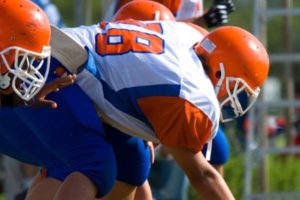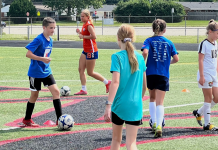“Rub some dirt on it. Shake it off. Take a lap. You’ll feel better after you puke. You got your bell rung.”
These phrases probably sound familiar if you’ve experienced a concussion playing sports. If you are concerned your youth athlete may learn these phrases firsthand, you can rest easier knowing the culture is changing in the management and treatment of traumatic brain injuries. To assure today’s youth athletes are at less risk of receiving a concussion (Note: there will always be risks in sports), sports medicine physicians and athletic trainers are teaming up to provide preventative and efficient measures to make sure athletes are free of symptoms before taking the field.
Baseline concussion testing, for a start, allows medical professionals the opportunity to:
1. Define a child’s mental speed, accuracy and memory prior to injury.
2. Assure that the child returns to that defined competency level before returning to learn or sports after injury.
If an athlete receives multiple concussions in a single season, the medical staff removes these athletes from play. Ideally, they should stay out for as long as it takes to recover – anywhere from a few months to a year or more. This practice has been suggested for many years, but there has been a lack of buy-in from sports administrators, coaches, leagues and sometimes parents. Not anymore.
In the medical field, support from governing bodies has been the final piece needed to end the argument that there is a difference between a brain injury and just “getting your bell rung”. Governing bodies, such as USA Soccer, now state that players cannot re-enter play on the same day they received clearance from a physician or not – no play, period. This governing body is host to a number of organizations where athletes are asked to play multiple games daily, often driving to multiple sites, so it would be easy to let a concussed player slip through and enter the field of play while injured. Pulling their player card and crossing their name out for a set amount of time allows for a re-education on what is acceptable when managing a concussion in youth sports. This move by USA soccer (whether intentional or not) supports what physicians and athletic trainers have stated for decades: multiple head injuries are not worth potential long-term side effects in exchange for sports glory.
Other governing bodies – such as OHSAA – require that only a physician, athletic trainer or nurse (with physician clearance) can clear an athlete to attempt a return to sports. OHSAA also makes it clear that coaches, officials and parents are required by law to educate themselves on concussion symptoms, protocol and learn the definition of physician and athletic trainer roles in sports healthcare. The CDC continues to expand literature on pediatric concussions, and the future of evaluations will include software that measures eye movement, blood and glucose testing along with baseline tests and physical evaluations.
Good mental health is more valuable than a sports trophy. Parents can help keep their kids safe by reviewing proper techniques for the sports their kids play, and discussing their health with a sports medicine physician during pre-participation physicals. Baseline test your athletes before seasons begin to ensure best route to recovery when injured.
In the end, sports can be highly rewarding to young children. More rewarding still is having a healthy brain. With improved guidelines and preventative measures that will protect our your youth, the future of concussion care is quickly clearing.
By Nathan McFadden, Supervisor
Sports Medicine, PM&R
Nathan McFadden is the lead outreach athletic trainer for Dayton Children’s sports medicine. A graduate of Marshall University, Nathan has practiced athletic training in Ohio, Michigan and West Virginia as a graduate assistant for the Thundering Herd, as well writing blogs on endurance event sports. Areas of expertise include concussion awareness, injury prevention and strength training.
















